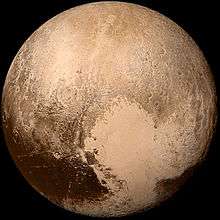(120178) 2003 OP32
| Discovery | |
|---|---|
| Discovered by | M. E. Brown, C. Trujillo, D. Rabinowitz[1] |
| Discovery date | 26 July 2003 |
| Designations | |
| MPC designation | (120178) 2003 OP32 |
|
Cubewano (MPC)[2] Extended (DES)[3] | |
| Orbital characteristics[4] | |
| Epoch 13 January 2016 (JD 2457400.5) | |
| Uncertainty parameter 3 | |
| Observation arc | 9205 days (25.20 yr) |
| Aphelion | 47.620 AU (7.1239 Tm) |
| Perihelion | 38.480 AU (5.7565 Tm) |
| 43.050 AU (6.4402 Tm) | |
| Eccentricity | 0.10615 |
| 282.47 yr (103172 d) | |
Average orbital speed | 4.51 km/s |
| 71.841° | |
| 0° 0m 12.561s / day | |
| Inclination | 27.219° |
| 182.930° | |
| 67.082° | |
| Earth MOID | 37.5618 AU (5.61917 Tm) |
| Jupiter MOID | 33.5815 AU (5.02372 Tm) |
| Jupiter Tisserand parameter | 5.208 |
| Physical characteristics | |
| Dimensions | 230 km[5][6] |
| 9.71 h (0.405 d) | |
Sidereal rotation period | 8.45 h[7] |
| 0.7 (assumed) | |
| Temperature | ~42 K |
|
(Neutral) B0-V0=0.698[7] | |
| 3.8[4] | |
|
| |
(120178) 2003 OP32, also written as (120178) 2003 OP32, is a trans-Neptunian object (TNO) that resides in the Kuiper belt. It was discovered on July 26, 2003 by Michael E. Brown, Chad Trujillo and David L. Rabinowitz at Palomar Mountain in California.
Origin
Based on their common pattern of infrared water-ice absorption and the clustering of their orbital elements,[9] the other KBOs 1995 SM55, (19308) 1996 TO66, (55636) 2002 TX300 and (145453) 2005 RR43, among others, appear to be collisional fragments broken off the dwarf planet Haumea. The neutral color of the spectrum of these objects in the visible range evidences a lack of complex organics on the surface of these bodies that has been studied in detail for the surface of Haumea.[10]
References
- ↑ List Of Transneptunian Objects Archived 2007-06-21 at WebCite
- ↑ "MPEC 2009-R09 :Distant Minor Planets (2009 SEPT. 16.0 TT)". IAU Minor Planet Center. 2009-09-04. Retrieved 2009-10-04.
- ↑ Marc W. Buie (2005-09-03). "Orbit Fit and Astrometric record for 120178". (using 41 of 42 observations) SwRI (Space Science Department). Retrieved 2009-10-04.
- 1 2 "JPL Small-Body Database Browser: 120178 (2003 OP32)". (last obs). 2009-07-19. Retrieved 11 April 2016.
- ↑ Assuming a Haumea-like albedo of 0.7
- ↑ Dan Bruton. "Conversion of Absolute Magnitude to Diameter for Minor Planets". Department of Physics & Astronomy (Stephen F. Austin State University). Retrieved 2009-12-27.
- 1 2 David L. Rabinowitz; Bradley E. Schaefer; Martha W. Schaefer; Suzanne W. Tourtellotte (2008). "The Youthful Appearance of the 2003 EL61 Collisional Family". The Astronomical Journal. 136: 1502–1509. arXiv:0804.2864
 . Bibcode:2008AJ....136.1502R. doi:10.1088/0004-6256/136/4/1502.
. Bibcode:2008AJ....136.1502R. doi:10.1088/0004-6256/136/4/1502. - ↑ Snodgrass, Carry; Dumas, Hainaut (16 December 2009). "Characterisation of candidate members of (136108) Haumea's family". Astronomy and Astrophysics. 511: A72. arXiv:0912.3171
 . Bibcode:2010A&A...511A..72S. doi:10.1051/0004-6361/200913031.
. Bibcode:2010A&A...511A..72S. doi:10.1051/0004-6361/200913031. - ↑ Pinilla-Alonso, N.; Licandro, J.; Gil-Hutton, R.; Brunetto, R. (June 2007). "The water ice rich surface of (145453) 2005 RR43: a case for a carbon-depleted population of TNOs?". Astronomy and Astrophysics. 468 (1): L25. arXiv:astro-ph/0703098
 . Bibcode:2007A&A...468L..25P. doi:10.1051/0004-6361:20077294.
Pinilla-Alonso et al. 2007
. Bibcode:2007A&A...468L..25P. doi:10.1051/0004-6361:20077294.
Pinilla-Alonso et al. 2007 - ↑ N. Pinilla-Alonso; R. Brunetto; J. Licandro; R. Gil-Hutton; T. L. Roush & G. Strazzulla (March 2009). "Study of the Surface of 2003 EL61, the largest carbon-depleted object in the trans-neptunian belt". Astronomy and Astrophysics. 496 (2): 547–556. arXiv:0803.1080
 . Bibcode:2009A&A...496..547P. doi:10.1051/0004-6361/200809733.
. Bibcode:2009A&A...496..547P. doi:10.1051/0004-6361/200809733.
External links
- Orbital simulation from JPL (Java) / Ephemeris
- (120178) 2003 OP32 Precovery Images
- (120178) 2003 OP32 at the JPL Small-Body Database

_(cropped).jpg)
